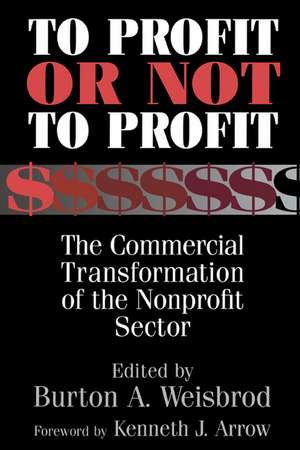To Profit or Not to Profit: The Commercial Transformation of the Nonprofit Sector
Editat de Burton A. Weisbrod Cuvânt înainte de Kenneth J. Arrowen Limba Engleză Paperback – 30 apr 2000
| Toate formatele și edițiile | Preț | Express |
|---|---|---|
| Paperback (1) | 378.58 lei 6-8 săpt. | |
| Cambridge University Press – 30 apr 2000 | 378.58 lei 6-8 săpt. | |
| Hardback (1) | 783.81 lei 6-8 săpt. | |
| Cambridge University Press – 12 sep 1998 | 783.81 lei 6-8 săpt. |
Preț: 378.58 lei
Nou
Puncte Express: 568
Preț estimativ în valută:
72.45€ • 78.67$ • 60.86£
72.45€ • 78.67$ • 60.86£
Carte tipărită la comandă
Livrare economică 23 aprilie-07 mai
Preluare comenzi: 021 569.72.76
Specificații
ISBN-13: 9780521785068
ISBN-10: 0521785065
Pagini: 356
Ilustrații: 33 tables
Dimensiuni: 158 x 235 x 24 mm
Greutate: 0.52 kg
Ediția:Revised.
Editura: Cambridge University Press
Colecția Cambridge University Press
Locul publicării:New York, United States
ISBN-10: 0521785065
Pagini: 356
Ilustrații: 33 tables
Dimensiuni: 158 x 235 x 24 mm
Greutate: 0.52 kg
Ediția:Revised.
Editura: Cambridge University Press
Colecția Cambridge University Press
Locul publicării:New York, United States
Cuprins
Preface; Introduction; 1. The nonprofit mission and its financing: growing links between nonprofits and the rest of the economy Burton A. Weisbrod; Part I. Basic Issues and Perspective: 2. Competition, commercialization, and the evolution of nonprofit organizational structures Howard P. Tuckman; 3. Modeling the nonprofit organization as a multi-product firm: a framework for choice Burton A. Weisbrod; 4. Pricing and rationing nonprofit organizations with distributional objectives Richard Steinberg and Burton A. Weisbrod; 5. Differential taxation of nonprofits and the commercialization of nonprofit revenues Joseph J. Cordes and Burton A. Weisbrod; 6. Interdependence of commercial and donative revenues Lewis M. Segal and Burton A. Weisbrod; 7. Conversion from nonprofit to for-profit legal status: why does it happen and should anyone care? John H. Goddeeris and Burton A. Weisbrod; Part II. Industry Studies: 8. Commercialism in nonprofit hospitals Frank A. Sloan; 9. Universities as creators and retailers of intellectual property: life sciences research and economic development Walter W. Powell and Jason Owen-Smith; 10. Commercialism in nonprofit social service associations: its character, significance, and rationale Dennis R. Young; 11. Zoos and aquariums Louis Cain and Dennis Meritt, Jr; 12. Commerce and the muse: are art museums becoming commercial? Helmut K. Anheier and Stefan Toepler; 13. The funding perils of the corporation for public broadcasting Craig L. LaMay and Burton A. Weisbrod; Part III. Concluding Remarks: 14. Commercialism among nonprofits: objectives, opportunities and constraints Estelle James; 15. Conclusions and public policy issues: commercialism and the road ahead Burton A. Weisbrod; References.
Recenzii
'How can we explain the existence of organisations such as charities and voluntary agencies, which deliberately eschew profit-making? Burton Weisbrod has been in the forefront of the debate on this question, arguing that a combination of market failure and government failure in the provision of jointly consumed goods gives rise to a residual demand that can be met efficiently by the 'third sector'… the puzzles about non-profit behaviour are not just matters for economists. The role of the third sector is very much a matter for public-policy debate and political decision-making … This book reminds us that pressures on the sector to expand its role can ultimately damage the very features that have made it so attractive to politicians in the first place - its ability to respond efficiently to the needs of society's most vulnerable and excluded members.' The Times Higher Education Supplement
Descriere
This book, first published in 1998, asks why fundraising nonprofits are mimicking private firms and what consequences this is having.












